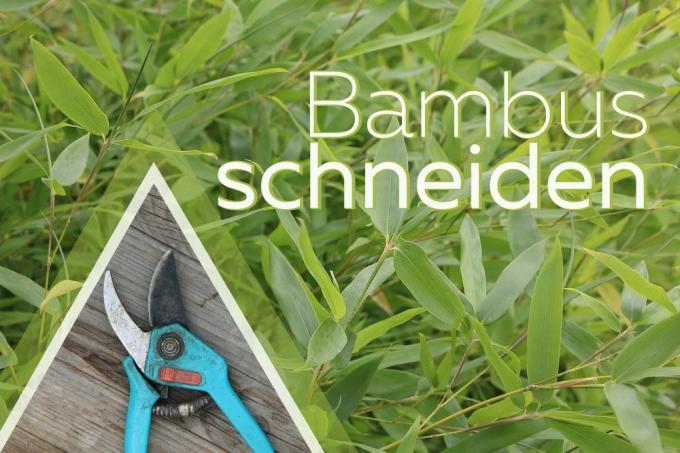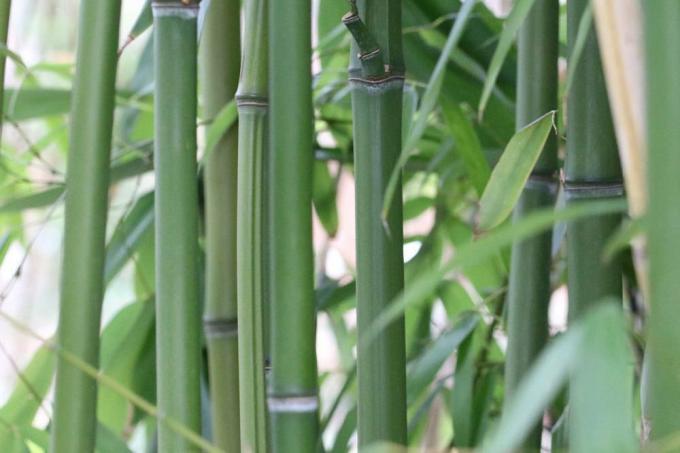
table of contents
- Bamboo varieties
- Cut
- Correction cut
- Main cut
- Taper cut
- Cut back
- Hedge trimming
- Step cut instructions
- Cut after frost damage
- Tools
Bamboo is now one of the popular garden plants in Germany as well. Whether as a solitary, hedge or ground cover, the different varieties allow numerous design options. Bamboo is considered easy to care for, but you should cut it regularly so that it grows lush and dense. Instructions for the most common types can be found here.
Bamboo varieties
Botanically, bamboo is not a wood, because the subfamily Bambusoideae (bamboo) belongs to the sweet grass family (Poaceae). The 1,000 to 1,500 species of bamboo are native to all continents with the exception of Europe and Antarctica.
The following varieties are widespread in this country:
- Flat tube bamboo (Phyllostachys) as a solitary plant
- Umbrella bamboo (Fargesia) for hedges
- Dwarf bamboo (Pleiobastus pymaeus) as a ground cover

Cut
There are several reasons for cutting garden plants:
- more compact and denser growth
- too little space
- Plant too big
- Plant begins to shed
- Lack of light
- rejuvenation
- Illness or damage
- shape
Depending on the goal of the cut, a general distinction is made:
- Care cut
- Taper cut
- Hedge trimming
- Care cut
In the maintenance cut, a distinction is made between correction and main cuts.
Correction cut
The corrective cut is made before the bamboo begins to sprout again. Depending on the weather, this is in March or April.
The aim of the first correction cut is:
- the elimination of winter damage
- the promotion of new growth
The first correction cut is easy to carry out and does not actually require much guidance. It is important that you have the growth behavior of the plant in mind, because bamboo stalks have no annual growth. This means that the individual stalks reach their final height within one growing season. If a stalk is shortened, it no longer grows in height. Despite this growth behavior, you do not need to be too careful when pruning, because it promotes the new shoots and the plant grows more luxuriantly as more light enters the interior of the plant comes.
Main cut
The main cut is made when the bamboo has completely sprouted again, i.e. has new leaves throughout and the side branches are completely unfolded.

The aim of the main cut is:
- Limiting growth
- Removal of non-integrated side branches
Tip: Unsightly leaves can be cut off throughout the summer.
Taper cut
Garden bamboos can live for a good ten years. Since the plants tend to shed, a rejuvenating cut should definitely be carried out so that the garden bamboo continues to thrive. In addition, a taper cut ensures that more light comes into the interior of the plant, which leads to more lush growth. The best time for the rejuvenation pruning is autumn, but it can also be carried out in the spring before the new growth in connection with the corrective pruning.
In the so-called thinning out:
- weak and old stalks cut off just above the ground
- cut dry and thin stalks just above the ground
Tip: If in doubt, it is better to cut more stalks than too few.
Taper cut in height
Basically, a taper cut can be made in height. However, you should bear in mind that the individual stalks no longer grow in height, but instead become bushier. As a result, the typical appearance of the plant can change. Therefore, you should not shorten stalks that are too tall, but remove them completely.
Taper cut as radical cut
In the case of very old bamboos, you can also shorten all the stalks by a third to rejuvenate them.
Cut back
A complete pruning of garden bamboo should generally be carried out every four to five years. The best time for this is before the new shoots in spring. This radical cut cuts up to a maximum of 20 centimeters above the ground.

Tip: Before completely pruning, find out how often it should be done on your bamboo variety.
Hedge trimming
If the bamboo hedge serves as a privacy screen, you should think of the growth behavior of the plants with regard to the height of the hedge, because after all, the hedge should have a certain height. If the width of the hedge has to be reduced, the cut is carried out as with other garden hedges. The laterally protruding shoots are simply cut to a uniform length. The best time to cut the bamboo hedge is in late autumn.
Tip: In colder regions, it is advisable to cut the bamboo hedge in spring before new growth.
Step cut instructions
In order for the bamboo hedge to keep its neat appearance, a step cut is often used.
Proceed according to the following instructions:
- Shorten the stalks in the middle of the hedge to the desired height
- Cut the stalks shorter at the edges of the hedge
So that the step cut is retained in the following years, the regrowing stalks must be shortened to the appropriate height.
Cut after frost damage
Although bamboo survives the German winter well, very low temperatures can cause problems and leaves and stalks turn brown. In this case, you should first be patient, keep calm and wait until June before cutting. Then you can see which parts of the plant have recovered, i.e. which have sprouted green leaves. If areas of the plant remain brown, don't remove them until August as they still contain nutrients.
The plant has usually suffered fatal frost damage when there are still no green leaves to be seen in June. Then you can cut the entire plant off at ground level.

Tools
Different tools are used to ensure that each cut is successful. However, all knives and scissors must be sharp and clean. The sharpness allows a smooth cut and the cleanliness prevents diseases and pests from being transmitted through the cutting tool.
Tip: If you have not used the cleaned cutting tool for a long time, you should definitely clean it before cutting.
Rose or secateurs
These scissors are suitable for cutting side branches or thin stalks.
Hedge or loppers
These tools are used for thick stalks and hedges.
knife
For example, a sharp knife can be used to step cut a bamboo hedge.



